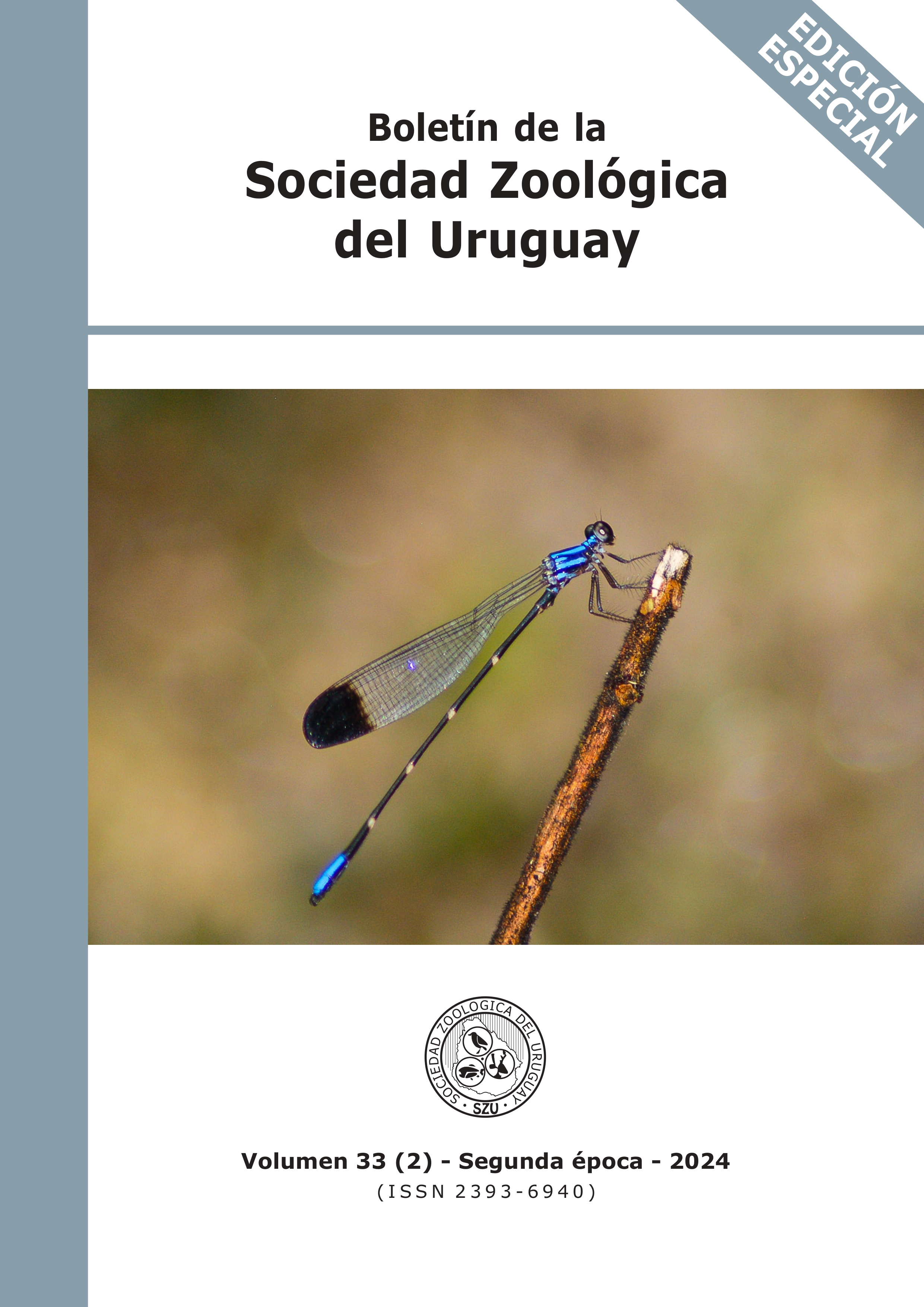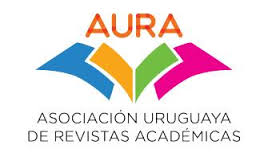ECOLOGICAL QUALITY AND ECOSYSTEM SERVICES IN THE JORDÁN-CHICAMOCHA RIVER
DOI:
https://doi.org/10.26462/33.2.1Keywords:
Macroinvertebrates, pollution, physical degradation, urbanizationAbstract
The Jordán-Chicamocha River, born in the Runta district south of Tunja, has undergone significant changes due to human development, which has led to eutrophication, loss of vegetation cover, and increased frequency of flooding. The ecological quality and ecosystem services (ES) were evaluated in three sections of the river through in situ sampling of physicochemical variables and analysis of benthic macroinvertebrates, identifying 13 families, with a predominance of Tubificidae and Glossiphoniidae. These findings are related to high levels of hardness, phosphates, nitrates and electrical conductivity, in addition to evidence of physical degradation in the riverbed and riverbank. According to the Andean Biological Index (ABI), the ecological quality is classified as moderate, very poor, and poor. A total of 100 surveys indicated that, despite the provision of wildlife habitats and water availability, these benefits diminish with increased urbanization and lower ecological quality. Anthropogenic activities exert pressure on the ecosystem, altering the composition and distribution of the evaluated community and affecting the ecological quality, functions and services of the aquatic ecosystem.
Downloads
References
Acosta, J., González, L., & Cuellar, L.A. (2020). Determinación de microorganismos presentes en el cauce del río Jordán, sector peaje Tuta via Tunja-Paipa. @ limentech, Ciencia y Tecnología Alimentaria, 18(1), 5–21. https://doi.org/10.24054/16927125.v1.n1.2020.4144
Acosta, R., Ríos, B.M., Rieradevall, M., & Prat, N. (2009). Propuesta de un protocolo de evaluación de la calidad ecológica de ríos andinos (CERA) y su aplicación a dos cuencas en Ecuador y Perú. Limnetica, 28(1), 35–64. https://doi.org/10.23818/limn.28.04
Al, M.A., Akhtar, A., Kamal, A.H.M., AftabUddin, S., Islam, M.S., & Sharifuzzaman, S.M. (2022). Assessment of benthic macroinvertebrates as potential bioindicators of anthropogenic disturbance in southeast Bangladesh coast. Marine Pollution Bulletin, 184, 114217. https://doi.org/10.1016/j.marpolbul.2022.114217
Alric, B., Geffard O., Chaumot, A. (2022). Metal bioavailable contamination engages richness decline, species turnover but unchanged functional diversity of stream macroinvertebrates at the scale of a French region. Environmental Pollution. 308, 119565. https://doi.org/10.1016/j.envpol.2022.119565.
Baker, N.J., & Greenfield, R. (2019). Shift happens: Changes to the diversity of riverine aquatic macroinvertebrate communities in response to sewage effluent runoff. Ecological Indicators, 102, 813-821. https://doi.org/10.1016/j.ecolind.2019.03.021
Benites, A. (2007). Manejo participativo de los recursos naturales basado en la identificación de servicios ecosistémicos en la cuenca del río Otún-Pereira, Colombia. [Tesis de maestría, Centro Agronómico Tropical de Investigación y Enseñanza]. CATIE. https://repositorio.catie.ac.cr/handle/11554/5315
Beyene, A., Abate, M. Sinshaw, B. Belete, A. & Chekole, B. (2023). Anthropogenic amplification of geomorphic processes on fluvial channel morphology, case study in Gilgel Abay river mouth; lake Tana Sub Basin, Ethiopia. Heliyon, 9(4). https://doi.org/10.1016/j.heliyon.2023.e14390
Bolaños-Alfaro, J.D., Cordero-Castro, G., & Segura-Araya, G. (2017). Determinación de nitritos, nitratos, sulfatos y fosfatos en agua potable como indicadores de contaminación ocasionada por el hombre, en dos cantones de Alajuela (Costa Rica). Revista Tecnología en Marcha, 30(4), 15-27. https://doi.org/10.18845/tm.v30i4.3408
Campos, C.A., Kennard, M.J., & Júnior, J.F.G. (2021). Diatom and Macroinvertebrate assemblages to inform management of Brazilian savanna's watersheds. Ecological Indicators, 128, 107834. https://doi.org/10.1016/j.ecolind.2021.107834
Chaquea, M. (2017). Análisis físico y químico de la calidad del agua. Bogotá. Ediciones USTA. https://doi.org/10.15332/li.lib.2017.0003
Chen, J.M., Yang, T., Wang, Y., Jiang, H., & He, C. (2022). Effects of ecological restoration on water quality and benthic macroinvertebrates in rural rivers of cold regions: A case study of the Huaide River, Northeast China. Ecological Indicators, 142, 109169. https://doi.org/10.1016/j.ecolind.2022.109169
De Carvalho, A.R., Garcia, F., Riem Galliano, L., Tudesque, L., Albignac, M., Ter Halle, A., & Cucherousset, J. (2021). Urbanization and hydrological conditions drive the spatial and temporal variability of microplastic pollution in
the Garonne River. Science of the Total Environment, 769, 144479. https://doi.org/10.1016/j.scitotenv.2020.144479
Dirisu, A., & El Surtasi, E.I. (2021). Bioindicators of lotic and lentic ecosystems in Agbede wetlands (Southern Nigeria), using macroinvertebrate tools. Scientific African, 14, e01000. https://doi.org/10.1016/j.sciaf.2021.e01000
Erasmus, J.H., Lorenz, A.W., Zimmermann, S., Wepener, V., Sures, B., Smit, N.J., & Malherbe, W. (2021). A diversity and functional approach to evaluate the macroinvertebrate responses to multiple stressors in a small subtropical austral river. Ecological Indicators, 131, 108206. https://doi.org/10.1016/j.ecolind.2021.108206
Fernandes, A.C.P., de Oliveira Martins, L.M., Pacheco, F.A.L., & Fernandes, L.F.S. (2021). The consequences for stream water quality of longterm changes in landscape patterns: Implications for land use management and policies, Land Use Policy, 109, 105679. https://doi.org/10.1016/j.landusepol.2021.105679.
Fernández, H.R., & Domínguez, E. (2001). Guía para la determinación de los artrópodos bentónicos sudamericanos (Vol. 1). Tucumán: Universidad Nacional de Tucumán, Facultad de Ciencias Naturales e Instituto M. Lillo.
Gál, B., Szivák, I., Heino, J., & Schmera, D. (2019). The effect of urbanization on freshwater macroinvertebrates–knowledge gaps and future research directions. Ecological indicators, 104, 357-364. https://doi.org/10.1016/j.ecolind.2019.05.012
Gómez-Baggethun, E., & de Groot, R. (2007). Capital natural y funciones de los ecosistemas: explorando las bases ecológicas de la economía. Ecosistemas: Revista Científica Y Técnica de Ecología y Medio Ambiente, 16(3), 4-14.
Gopal, B. (2016). A conceptual framework for environmental flows assessment based on ecosystem services and their economic valuation. Ecosystem services, 21, 53-58.
Gualdrón, L. (2018). Evaluación de la calidad de agua de ríos de Colombia usando parámetros físicoquímicos y biológicos. Dinámica Ambiental, 1, 83-102. https://doi.org/10.18041/2590-6704/ambiental.1.2016.4593
Huang, Z., Chen, Y., Zheng, Z., & Wu, Z. (2023). Spatiotemporal coupling analysis between human footprint and ecosystem service value in the highly urbanized Pearl River Delta urban Agglomeration, China. Ecological Indicators, 148, 110033. https://doi.org/10.1016/j.ecolind.2023.110033
Íñiguez-Ayón, Y.P. (2020). La vegetación ribereña y su importancia para las ciudades. Estudio de caso: río Humaya, Culiacán, Sinaloa. Boletín Científico Sapiens Research, 10(2), 91-100. https://dialnet.unirioja.es/descarga/articulo/7711518.pdf
Lei, C., Wang, Q., Wang, Y., Han, L., Yuan, J., Yang, L., & Xu, Y. (2022). Spatially non-stationary relationships between urbanization and the characteristics and storage-regulation capacities of river systems in the Tai Lake Plain, China. Science of The Total Environment, 824, 153684. https://doi.org/10.1016/j.scitotenv.2022.153684
Lencioni, V., Bellamoli F., & Paoli, F. (2020). Multi-level effects of emerging contaminants on macroinvertebrates in Alpine streams: From DNA to the ecosystem, Ecological Indicators, 117. https://doi.org/10.1016/j.ecolind.2020.106660.
Lourdes, K.T., Hamel, P., Gibbins, C.N., Sanusi, R., Azhar, B., & Lechner, A.M. (2022). Planning for green infrastructure using multiple urban ecosystem service models and multicriteria analysis. Landscape and Urban Planning, 226, 104500. https://doi.org/10.1016/j.landurbplan.2022.104500
Maue, T., & Springer, M. (2008). Effect of methodology and sampling time on the taxa richness of aquatic macroinvertebrates and subsequent changes in the water quality index from three tropical rivers, Costa Rica. Revista de Biología Tropical, 56(4), 257-271. https://doi.org/10.15517/rbt.v56i4.27231
Meneses, Y., Castro, M., & Jaramillo, A. (2019). Comparación de la calidad del agua en dos ríos altoandinos mediante el uso de los índices BMWP/COL. y ABI. Acta biológica colombiana, 24(2), 299-310. https://doi.org/10.15446/abc.v24n2.70716
Montilla, V.B., Márquez, J., Principe, R. (2022). Aquatic macroinvertebrates as bioindicators of the harvest effect on mountain streams afforested with exotic pines. Limnologica, 95. https://doi.org/10.1016/j.limno.2022.125988.
Odume, O.N. (2020). Searching for urban pollution signature and sensitive macroinvertebrate traits and ecological preferences in a river in the Eastern Cape of South Africa. Ecological Indicators, 108, 105759. https://doi.org/10.1016/j.ecolind.2019.105759
Pennak, R. (1978). Fresh-water Invertebrates of the United States. Ronald Press Company. Perico, N., Caro, C., Acevedo, W., Sánchez, D., Dávila, M., & Arévalo, H. (2019). Zonas de inundación, Ríos Jordán y La Vega, Tunja. Ingenio Magno, 10(1), 10-22. http://revistas.ustatunja.edu.co/index.php/ingeniomagno/article/view/1912
Pérez, J., Martínez-Romero, L., Castellanos-Guerrero, L. Mora-Parada, A., Rocha-Gil, Z. (2020). Macroinvertebrados bioindicadores de calidad de agua en sistemas hídricos artificiales del Departamento de Boyacá, Colombia. Producción + Limpia, 15 (1), 35–48. https://doi.org/10.22507/pml.v15n1a3
Qiu, J., Yu, D., & Huang, T. (2022). Influential paths of ecosystem services on human well-being in the context of the sustainable development goals. Science of The Total Environment, 852, 158443. https://doi.org/10.1016/j.scitotenv.2022.158443
Quesada- Alvarado, F., Villalobos, G.U., Springer M., & Picado-Barboza J. (2020). Variación estacional y características fisicoquímicas e hidrológicas que influyen en los macroinvertebrados acuáticos, en un río tropical. Revista de BiologíaTropical, 68(2), 54-67. http://dx.doi.org/10.15517/rbt.v68is2.44332
Ramírez, A. (2010). Capítulo 2: Métodos de recolección. Revista de Biología Tropical, 58, 41-50.
Rodriguez. J.; Pinilla, G., Moncada, L.I.M. (2021). Estructura de la comunidad de dípteros acuáticos en tramos de los cursos altos de los ríos Fucha y Bogotá. Acta biológica colombiana, 26(2), 147-159. https://doi.org/10.15446/abc.v26n2.81916
Rodríguez, N., & Ramírez, A. (2018). Protocolo de evaluación visual de quebradas para Puerto Rico. Río Piedras: Universidad de Puerto. DOI, 10(2.1), 4695-2326.
Roldán, G. (1988). Guía para el estudio de los macroinvertebrados acuáticos del Departamento de Antioquia. Fondo para la Protección del Medio Ambiente "José Celestino Mutis".
Rosado, Á.Y., Yanez, Á.B.Y., Zambrano, J.U., Cabezas, D.C.M., Chuez, N.M.G., & Cajas, C.C.T. (2017). Macroinvertebrados acuáticos como indicadores de calidad hídrica en áreas de descargas residuales al río Quevedo, Ecuador. Ciencia y Tecnología, 10(1), 27-34. https://doi.org/10.18779/cyt.v10i1.196
Samanez Valer, I., Rimarachín Ching, V., Palma Gonzales, C., Arana Maestre, J., Ortega Torres, H., Correa Roldán, V., & Hidalgo Del Águila, M. (2014). Métodos de colecta, identificación y análisis de comunidades biológicas: plancton, perifiton, bentos (macroinvertebrados) y necton (peces) en aguas continentales del Perú. Ministerio del Ambiente.
Stein, H., Springer, M., & Kohlmann, B. (2008). Comparison of two sampling methods for biomonitoring using aquatic macroinvertebrates in the Dos Novillos River, Costa Rica. Ecological engineering, 34(4), 267–275. https://doi.org/10.1016/j.ecoleng.2007.06.010
Stoffers, T., Buijse, A.D., Geerling, G.W., Jans, L.H., Schoor, M.M., Poos, J.J., ... & Nagelkerke, L.A.J. (2022). Freshwater fish biodiversity restoration in floodplain rivers requires connectivity and habitat heterogeneity at multiple spatial scales. Science of The Total Environment, 838,156509. https://doi.org/10.1016/j.scitotenv.2022.156509
Terneus-Jácome, E, & Yánez, P. (2018). Principios fundamentales en torno a la calidad del agua, el uso de bioindicadores acuáticos y la restauración ecológica fluvial en Ecuador. La granja. Revista de Ciencias de la Vida, 27(1), 36-50. https://doi.org/10.17163/lgr.n27.2018.03
Vagheei, H., Laini A., Vezza P., Palau-Salvador, G., & Boano, F. (2022). Ecohydrologic modeling using nitrate, ammonium, phosphorus, and macroinvertebrates as aquatic ecosystem health indicators of Albaida Valley (Spain), Journal of Hydrology: Regional Studies, 42, 101155. https://doi.org/10.1016/j.ejrh.2022.101155.
Wiggins, G.B. (1996). Larvae of the North American caddisfly genera (Trichoptera). University of Toronto Press.
Zhai, T., Chang, M., Ma, Y., Huang, L., & Li, L. (2023). Exploring the changes and driving mechanisms in the production-transport-consumption process of ecosystem services flow in the Yellow River Basin under the background of policy
changes, Ecological Indicators, 151, 110316, ISSN 1470-160X, https://doi.org/10.1016/j.ecolind.2023.110316.
Zhang, L., Sun, Q., Dou, Q., Lan, S., Peng, Y., & Yang, J. (2022). The molecular characteristics of dissolved organic matter in urbanized river sediments and their environmental impact under the action of microorganisms. Science of The Total Environment, 827, 154289. https://doi.org/10.1016/j.scitotenv.2022.154289
Zhu, Q., Guo, J., Guo, X., Chen, L., Han, Y., & Liu, S. (2021). Relationship between ecological quality and ecosystem services in a red soil hilly watershed in southern China. Ecological Indicators, 121, 107119. https://doi.org/10.1016/j.ecolind.2020.107119











